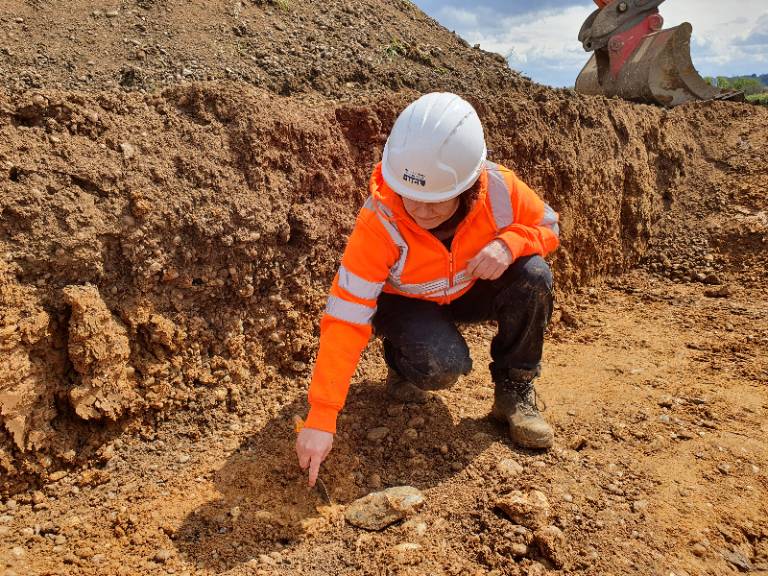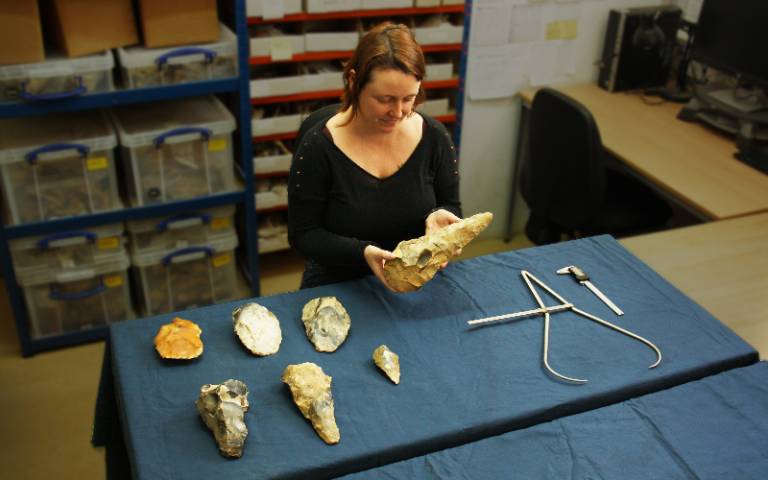A trove of around 800 stone tools, including what archaeologists described as “giant hand axes,” was found in a dig in Kent, England—shedding light on an era when Neanderthals were beginning to emerge in Britain. Researchers surprisingly found a Roman cemetery from hundreds of thousands of years later at the same site.
Letty Ingrey, a senior archaeologist with the University College London’s Institute of Archaeology, described the stone tools as being so big that it’s hard to imagine them being held and used, according to a news release. The findings were published Thursday in Internet Archaeology.
“Perhaps they fulfilled a less practical or more symbolic function than other tools, a clear demonstration of strength and skill,” Ingrey said. “While right now, we aren’t sure why such large tools were being made, or which species of early human were making them, this site offers a chance to answer these exciting questions.”

An archaeologist points to one of the hand axes at the point of discovery on site. Photo courtesy of University College London
The dig was started in the spring of 2021 after the British construction company Bowmer + Kirkland, which was building a new school called the Maritime Academy, commissioned an archeological evaluation as part of the construction process.
The researchers found the stone tools in a body of sediment that would have been deposited by a tributary of the River Medway during the Middle Pleistocene era. Among the discoveries, which measure about 8.6 to 11.4 inches in length, was a flint cutting tool believed to be the third-largest ever found in Britain.
“The size of the hand axe and its distinctive symmetrical elongated tapering tip is typical of a type of hand axe known as a ficron,” researchers said in a description of a 3D model of the artifact. “Similar tools are known from the Medway Valley and across southern Britain.”

Location of the Maritime Academy Palaeolithic site. Top left shows the site’s location within the wider region. Top right shows the site’s position relative to the current course of the Medway and the Palaeolithic sites of Cuxton and Frindsbury All Saints. The bottom image shows a plan of the site including the geoarchaeological test pits and mitigation areas discussed in the text. Image courtesy of Internet Archaeology
Viewers of the 3D model can click and drag to rotate around the massive ficron and see how its creators chipped the stone to turn it into a tool. The tool measures nearly a foot long and weighs over three-and-a-half pounds.
In the journal article, the study authors called such hand axes “among the most impressive and arresting objects from our Middle Pleistocene record.” Though researchers said they are unsure of why such large handaxes were made, they believe such tools could have been used to butcher meat.
“The excavations at the Maritime Academy have given us an incredibly valuable opportunity to study how an entire Ice Age landscape developed over a quarter of a million years ago,” Matt Pope with the UCL Institute of Archaeology said in a statement.
“A program of scientific analysis, involving specialists from UCL and other U.K. institutions, will now help us to understand why the site was important to ancient people and how the stone artifacts, including the ‘giant hand axes’ helped them adapt to the challenges of Ice Age environments.”









